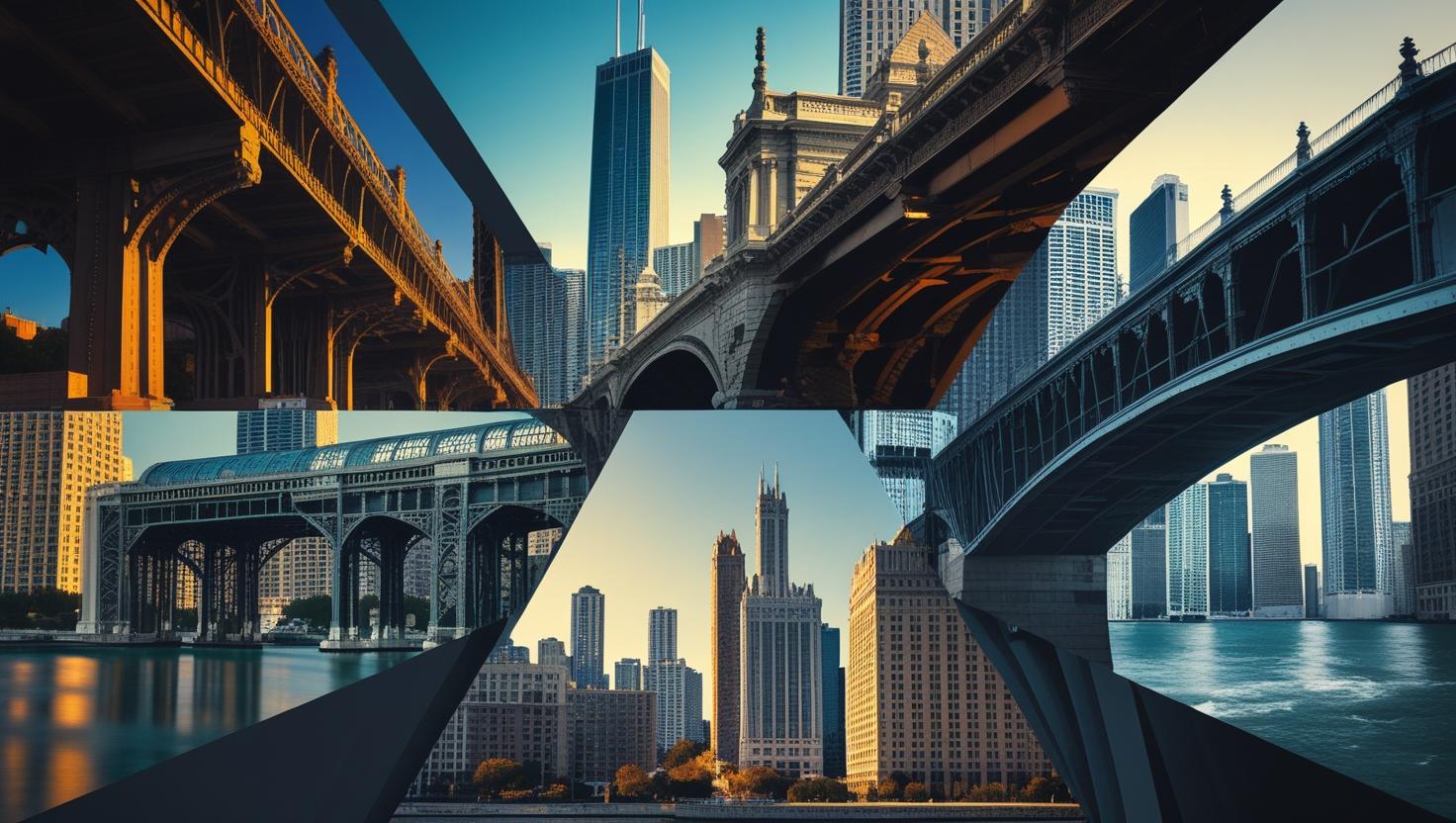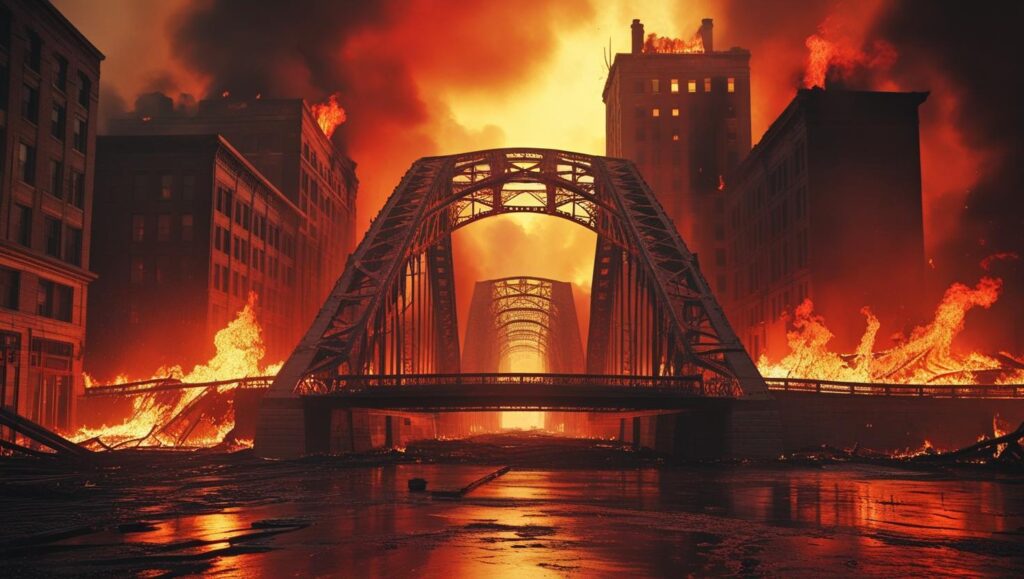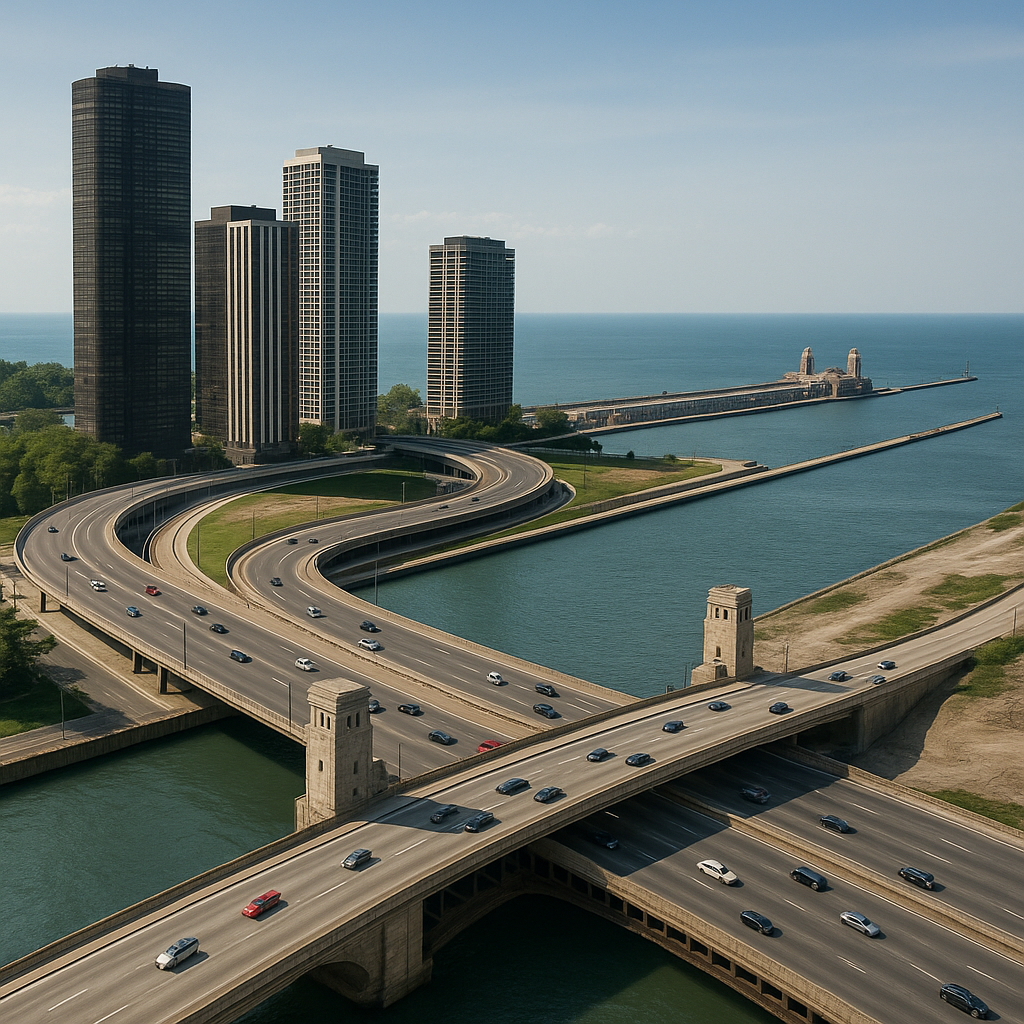
The History of Chicago’s Bridges
Published on June 12, 2025
With the Chicago River dividing the city into the North, South, and West Sides, bridges that could allow people and vehicles to cross while still allowing ships to pass through was necessary for Chicago’s growth. The city now has 37 movable bridges, 32 on the Chicago River and the others on the Calumet. That’s the most of any North American city, and second only to Amsterdam.
By Dave Lifton (@daveeatschicago)
The first crossed the river at Dearborn St. Built in 1834, one year after Chicago’s founding as a village, the wooden bridge only had a span of 60 feet. As a result, boats often hit it and its poor operation made it difficult to cross. Only five years later, the city called for its removal. According to one legend, it was destroyed by the public before it could be done officially. A plaque commemorating its role in Chicago history is at the northeastern section of the current bridge, directly below Marina City.
As the city grew, so did the need for more bridges. But in March 1849, several days of heavy rain caused a massive ice dam on the South Branch to break and flow towards Lake Michigan. The flood wiped out all four bridges in its path, at Clark, Wells, Randolph, and Madison Streets.
A swing bridge – the dominant design in the middle of the 19th century – was constructed from Rush Street to South Water St. (now Wacker Dr.) in 1857. However, it also met an untimely end six years later. A herd of cattle was being driven on the bridge at the very moment it was being swung to allow passage. The excess weight of the cows on the north side caused the bridge to collapse.
Another Rush Street Bridge was completed in 1864, but, as with its predecessor, it was short-lived. The Great Chicago Fire of 1871 destroyed it along with every other bridge in its path – at State, Clark, Wells, Adams, Van Buren, and Polk Streets. The ones at Lake and Randolph barely avoided the blaze.

Wood construction was banned in the aftermath of the fire, which paved the way for steel and a new technology. The Cortland Steet Bridge, opened in 1902, was the nation’s first trunnion bascule bridge, where the leaves are lifted through the lowering of counterweights in the riverbank pit. As with skyscrapers, their proliferation throughout the city caused the trunnion bascule bridge to be called “Chicago Style.”
One of the most important aspects of Daniel Burnham and Edward Bennett’s 1909 Plan of Chicago concerned connecting Michigan Ave. with its northern counterpart, Pine St., which would then be renamed Michigan Ave. It took 11 years for the two-level Michigan Ave. Bridge to come to fruition, and it resulted in the construction of the Wrigley Building and Tribune Tower, and the branding of Michigan Ave. as “The Magnificent Mile.” Modeled on the Pont Alexander III in Paris, the bridge houses contain bas-relief sculptures of four important moments in the city’s history: The 1673 journey of Marquette and Joliet, early settlers, the Battle of Fort Dearborn, and rebuilding Chicago after the fire. In 2010, the bridge was renamed after Jean Baptiste Pointe du Sable, the first permanent non-Indigenous resident of Chicago, who built his homestead at the site in the later decades of the 18th century.

The growth of the automobile meant more bridges were needed. In 1937, the Outer Drive Bridge was built to traverse the river at Lake Shore Drive. At 356’ x 81’, it was the longest and widest bascule bridge in the world at the time of its opening. At its southern end, traffic was routed via an S-curve down Wacker Dr. As cars became faster, the curve led to accidents and traffic jams. A four-year project to straighten the curve was completed in 1986.

Not all of Chicago’s bridges are movable. The Chicago Skyway, a 7.8-mile section of I-90, is a toll road that runs from the South Side neighborhood of Greater Grand Crossing to the Indiana border. Completed in 1958, the Skyway’s highest point is its span across the Calumet River, where it allows for 125 feet of clearance.
Nor are all of them made for cars. Pedestrian bridges provide access to the lakefront by crossing Lake Shore Drive at North Avenue Beach, Oakwood Beach, Burnham Park, 47th Street, and 51st Street. But the most striking is in the heart of downtown. The stainless steel, Frank Gehry-designed BP Pedestrian Bridge snakes its way above Columbus Drive from Millennium Park to Maggie Daley Park. Its longest segment runs parallel to the park, where it serves as a soundproof barrier during concerts at the Jay Pritzker Pavilion.
Lastly, one lesser-known Chicago bridge made headlines, albeit for infamous reasons. On Aug. 8th, 2004, Stefan Wohl, the driver of the Dave Matthews Band’s tour bus, decided to expel 800 pounds of human waste from its septic tank on the Kinzie Street Bridge as an architectural tour cruise was passing underneath. Wohl was fined $10,000, sentenced to 18 months of probation, and 150 hours of community service. Matthews also paid $200,000 to settle a state lawsuit.
The author always loves seeing the scheduled bridge lifts during the spring and fall to allow for boats to pass to and from the lake, even if he’s usually on the wrong side when it happens.

The Adventure starts when you say it does.
All eATLAS Adventures are designed and built by experienced eATLAS Whoa!Guides. They're always on. Always entertaining. And always ready to go.
Check out our Adventures!